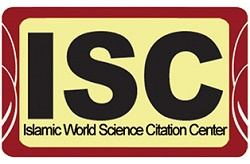The Safety and Physical Security in Tourism Spaces of the Border Areas
DOI:
https://doi.org/10.52547/ijimes.1.4.50DOR:
https://dorl.net/dor/20.1001.1.27832678.2021.1.4.5.1Keywords:
Physical Security, Tourists Safety, Varzgan, Border Areas, Promethean TechniqueAbstract
Purpose: The purpose of this study was to identify and define the physical factors affecting the security of Chichaklu, Gulakhor, Hamamlu, Zarabad Dam and Joushin castle as a tourism destination in Varzaghan border area, as well as the analysis of the relationship between their physical factors in Varzaghan and various aspects of tourism security.
Methodology: According to sample size formula, the sample size of this study is 268 internal and external tourists entering to the three tourism areas discussed. In this research, according to the research indicators, the Promethean Ranking technique was used in the tourists' physical security and for analysis of it, the version 1.4 of Promethee software was used.
Findings: According to the analysis of this technique and the graphs and numbers obtained from these analyzes, and given the positive flow, it can be seen that Zarabad Tourist Camp with the most positive flow is 0.6553. Hamamlu area with a positive flow of 0.2850 has the lowest level of physical security among target areas.
Originality/Value: This article is confirmed by Tarlow, 2014; Santos et al, 2017; Albakutherk23, & McElroy, 2011; Marcu 2015; Konrad, 2015; Vázquez, 2015 studies.
Downloads
References
Sojasi Qeidari, Hamdollah; Vazin Narges; Moradi Kebria & Zeinab Erfani (2020). Analyzing the Role of Security in local Societies Tourism Development Case Study: Rural Areas of Torqabeh and Shandiz County, Geopolitics Quarterly, Volume: 16, No 4, Winter 2021, 116-134.
Steinmetz Juergen (2019). Tourism Security will be an issue in 2020, The 26th Las Vegas International Tourism Safety and Security Conference in 27 years, U.S.A, May 5, 2019.
Tarlow, Peter (2014). “Tourism Security”, Strategies for Effectively Managing Travel Risk and Safety, 6th June 2014
Santos, Cátia, Daniel Silva, and Ericka Amorim. "The impact of Tourism Security on the Image of the Destination-The case of Portugal." Journal of Tourism Research 19 (2018): 207-216.
Kovari, I., & Zimányi, K. (2011). Safety and Security in the Age of Global Tourism (The changing role and conception of Safety and Security in Tourism). APSTRACT: Applied Studies in Agribusiness and Commerce, 5(1033-2016-84147), 59-61.
Marcu, S (2015). Between the (re) border and the border network: Cross-border mobility practices of immigrants from Eastern Europe in Spain Bulletin of the Association of Spanish Geographers (69) ,541-546
Martínez, C. Valdés Ciudad Juarez (1982). The rise of a border city from 1848 Fund of Economic Culture, Mexico.
Bringas, N. (2004). Border tourism: Characterization and development possibilities. Tijuana, Mexico: COLEF-CESTUR.
Campos Delgado, A. E., & Odgers Ortiz, O. (2012). Crossing the border: Mobility as a resource in the Tijuana/San Diego and Tecún Umán/Tapachula regions. Estudios fronterizos, 13(26), 9-32.
Parviznejad, P. S., & Akhavan, A. N. (2021). Impact of the Tourism Industry Scenarios in Urban Economy:(Case Study Tabriz). International Journal of Innovation in Management, Economics and Social Sciences, 1(1), 1-15.
Babaii, Morteza; Shahivandi, Ahmad & Mahmoudi, Mohammad. (2016). The Physical Pattern of Urban Spaces and its Effects on Tourism Corridors’ Safety/Security (Case Study: Jolfa, Bazaar and Zayanderud corridors in Isfahan), European Online Journal of Natural and Social Sciences 2016; Vol.5, No.4. 885-901.
Roehl, W. S., & Fesenmaier, D. R. (1992). Risk perceptions and pleasure travel: An exploratory analysis. Journal of Travel research, 30(4), 17-26.
Basala, S. L., & Klenosky, D. B. (2001). Travel-style preferences for visiting a novel destination: A conjoint investigation across the novelty-familiarity continuum. Journal of Travel Research, 40(2), 172-182.
Reisinger, Y., & Mavondo, F. (2005). Travel anxiety and intentions to travel internationally: Implications of travel risk perception. Journal of travel research, 43(3), 212-225.
Reichel et.al. (2007). Perceived risk and the non-Institutionalized tourist role: The case of Israeli student ex-backpackers. Journal of Travel Research, (46), 217-226.
Huang, Y. C., Tseng, Y. P., & Petrick, J. F. (2008). Crisis management planning to restore tourism after disasters: A case study from Taiwan. Journal of Travel & Tourism Marketing, 23(2-4), 203-221.
Bringas Rábago, N. L., & Verduzco Chávez, B. (2008). La construcción de la frontera norte como destino turístico en un contexto de alertas de seguridad. Región y sociedad, 20(42), 3-36.
Gelbman, D.J. (2011). Timothy Border complexity, tourism and international enclaves: A case study Annals of Tourism Research, 38 (1). 110-131.
Wastl-Walter, M.M. Varadi, F. Veider (2003). Coping with marginality: To stay or to go Journal of Ethnic and Migration Studies, 29 (5). 797-817.
Rumley,D. J.V. Minghi (1991). The geography of border landscapes Routledge, New York, EE.UU.
Hoekman, K. Frenken, F. Van Oort (2008). The geography of collaborative knowledge production in Europe Annals of Regional Science, (43), 721-738.
Parviznejad, P. S., & Bahrami, M. (2021). Uncertainty analysis of tourism components in Tabriz. International Journal of Innovation in Management, Economics and Social Sciences, 1(3), 1-14.
Hosseini, S. E., & Adibzadeh, B. (2008). physical security with approach of CPTED, a study of affecting environmental factors on creating safe spaces in organizing and designing urban worn out textures. In 1st conference of improvement and renovation of urban worn out textures (p. 2).
Stronza, J. Gordillo (2008). Community views of ecotourism Annals of Tourism Research, 35 (2) 448-468.
Giménez. G (2007). The northern border as a representation and cultural reference in Mexico Culture and Social Representations, 2 (3).
Nahr, J. G., Nozari, H., & Sadeghi, M. E. (2021). Green supply chain based on artificial intelligence of things (AIoT). International Journal of Innovation in Management, Economics and Social Sciences, 1(2), 56-63.
Siebel, w., & Wehrheim, j. (2003). Security and the urban public sphere. Urban studies, 42(2), 45-60.
Boyle, J., Findlay, C., & Forsyth, L. (2002). An Investigation into Women S Perception Of Fear and the Design of the Urban Environment, Open space.
Pyo, S., & Bouncken, R. B. (2003). Knowledge management in hospitality and tourism. CRC Press.
Kővári, I., & Zimányi, K. (2010). Safety and security in the age of global tourism. Applied Studies in Agribusiness and Commerce, 4(5-6), 67-69.
Popesku, J., & Pavlović, D. (2013). Competitiveness of Serbia as a tourist destination: Analysis of selected key indicators. Marketing, 44(3), 199-210.
Najar Zadeh, D., Baluchi, H., & Nematollahi, M. (2017). Investigating the Impact of Local People's Attitude on the Sustainability of Rural Areas in Developing Rural Tourism (Case Study: Qalat District of Shiraz). Geography and Territorial Spatial Arrangement, 7(24), 215-232.
del Río, J. A. J., Agüera, F. O., Cuadra, S. M., & Morales, P. C. (2017). Satisfaction in border tourism: An analysis with structural equations. European Research on Management and Business Economics, 23(2), 103-112.
Brans, J. P., & De Smet, Y. (2016). PROMETHEE methods. In Multiple criteria decision analysis (pp. 187-219). Springer, New York, NY.
Published
How to Cite
Issue
Section
License
Copyright (c) 2021 Abolfazl Ghanbari, Samira Hashemi Amin, Hamed Shali

This work is licensed under a Creative Commons Attribution 4.0 International License.












